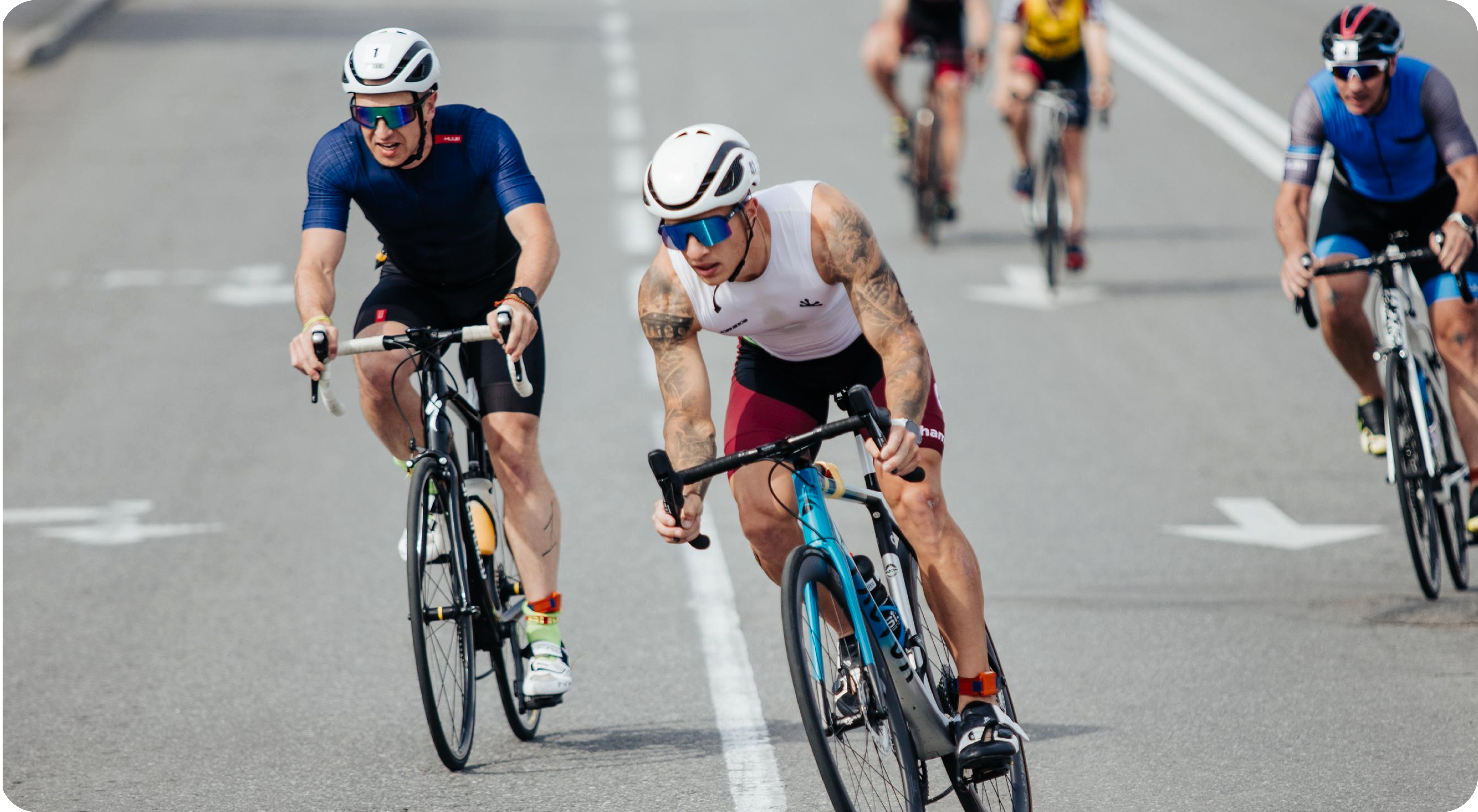TSS stands for Training Stress Score, and it is a metric that is commonly used to find out the intensity of your training session. In this article, I want to dive into what is TSS in cycling and discuss the importance of this metric, how to calculate it, and why TSS is important for your training.
Let’s go!
What is a Training Stress Score (TSS)?
Before drilling into what Training Stress Score (TSS) is and how it relates to cycling, there is another important metric to understand.
We are talking about FTP.
FTP (functional threshold power) is the maximum power that you can hold for 60 minutes.
However, it’s better viewed as your sustainable power, so for an untrained cyclist, it could be what they could manage for 30 minutes.
Another way of thinking about it is your cycling ‘red line’ that, if you push above it for too long, you’ll run out of gas.
Learn more about FTP testing strategies and how to test your FTP using a power meter and other techniques in our recent guide.
TSS in cycling is a metric developed to quantify the total training load of a workout.
It helps cyclists measure the intensity, duration, and physiological impact of their rides in a single number.
This is particularly useful for tracking fitness progress, planning recovery, and preventing negative overtraining effects like cramps while cycling.
How to Calculate TSS?
TSS combines the duration of a ride with its intensity, which is usually based on the cyclist’s Functional Threshold Power (FTP) or Heart Rate Threshold.
The formula for calculating TSS is:
TSS = (Seconds x NP X IF) / (FTP x 3600) x 100
Spelled out, this means:
Training Stress Score = (workout time in seconds x Normalized Power x Intensity Factor) / (Functional Threshold Power x number of seconds in an hour) x 100
Example: (7080 x 183 x .85) / (215 x 3600) x 100 = 142 TSS
- Duration: Total workout time in hours.
- Intensity Factor (IF): How hard the workout was compared to your FTP. For example, an IF of 1.0 means you worked at your threshold for the entire time.
- 100: A standard multiplier to scale the score.
TSS Categories
- 0-100: Light effort. Recovery rides or easy spins.
- 100-200: Moderate effort. A typical long ride or endurance session.
- 200+: Hard effort. High-intensity or very long rides.
Understanding Training Load
Training load is a way to measure how much work your body is doing during a workout.
It’s a mix of two things: how long you train and how hard you push yourself.
Essentially, it is calculated as:
Training Load=Duration×Intensity
How Does TSS Help?
Training Stress Score (TSS) takes this idea further. It doesn’t just look at time and effort — it estimates the physiological stress created after a workout.
This makes TSS incredibly useful for understanding your overall exercise load.
For instance, a short, tough interval session can have a similar training load to a long, steady endurance ride.
TSS helps compare these two types of workouts, even though they feel completely different.
Why Training Load Matters
Knowing and tracking your load will help you balance intensive workouts with rest days, so you can get stronger without overdoing it.
Another benefit is that you prevent burnout. Pushing too hard for too long can leave you feeling tired, injured, or stuck in a rut.
When you watch your TSS, you can better understand when it’s time to back off and recover.
Last but not least, when you manage your training load, you can plan hard efforts leading up to races or events while making sure you’re not overworked.
The Role of Intensity Factor in TSS
Intensity Factor (IF) is a critical component of the TSS calculation.
It’s what makes the score more than just a measure of ride duration — it brings in the challenge of how hard you’ve been working.
What is the Intensity Factor?
IF is a way to compare how hard your workout feels to your Functional Threshold Power (FTP):
- If your workout intensity matches your FTP, your IF is 1.0.
- If it’s easier, like a recovery ride, the IF will be lower.
- For very intense efforts, like sprints or hard intervals, the IF can go above 1.0.
How Does IF Shape Your TSS?
IF is key because it balances intensity and duration. For example:
- A 1-hour ride at your FTP (IF = 1.0) earns 100 TSS.
- A 2-hour ride at half your FTP (IF = 0.5) also earns 100 TSS, but the two rides feel very different.
This means TSS doesn’t just measure how long you ride — it considers how taxing the ride was on your body.
Knowing your IF is important for better training balance, workout structure planning, and more efficient progress tracking.
Over time, as your fitness improves, you may notice you can handle rides with a higher IF more easily, a great sign of progress.

How to Interpret Your TSS Score
Your TSS is like a report card for your rides. It tells you how hard your body worked. The higher the number, the more stressful the workout was for your muscles and cardiovascular system. So, if your TSS is through the roof after a long, climb-heavy ride, that’s no surprise — it was tough!
TSS is super useful because it helps you compare different types of rides. A short, intense interval session might have a similar TSS to a long, steady endurance ride. That means both pushed your body, just in different ways. While TSS doesn’t focus purely on intensity (that’s where Intensity Factor comes in), it gives you a clear picture of the overall toll a workout takes.
More importantly, looking at your TSS over days and weeks helps you spot trends. Are you consistently pushing too hard without enough recovery? Is your training load building up gradually as it should? That insight helps you avoid burnout and train smarter, not just harder.
And here’s a bonus tip: After high-TSS rides, don’t just rest. Stretching matters too. Including stretches for cyclists in your recovery routine can ease muscle tightness, improve flexibility, and help you bounce back faster for the next session.
Limitations of TSS: What it Doesn’t Tell You
Of course, the Training Stress Score is a helpful tool, but it’s not perfect.
It gives you a clear idea of how much stress a workout puts on your body, but there are a few key things it leaves out.
How was the stress created
TSS tells you the overall strain of a workout, but it doesn’t explain how you got there. For example:
- Was it a long, steady endurance ride?
- Or did it come from a short, intense ride?
Both might have the same TSS, but they affect your body in completely different ways.
When the stress happened
Timing matters when it comes to training. TSS doesn’t tell you whether:
- The stress was spread out over a few days, giving you time to recover.
- Or if you hit your body with a big load all at once.
This makes it tricky to gauge whether you’re properly recovered for your next workout.
Other life stress
TSS only tracks the stress from your workouts. It doesn’t factor in things like:
- Poor sleep
- A stressful day at work
- Personal challenges
These can affect your recovery and performance just as much as (or even more than) your training sessions.
Why Do You Need More Than TSS?
TSS is a great tool, but it’s only one piece of the puzzle.
To really understand your fitness, you should combine it with other metrics, like:
- How you’re feeling: Are you energized or dragging?
- Heart rate trends: How well is your body recovering?
- Performance improvements: Are you actually getting faster or stronger?
How to Manage Training Stress?
To manage training stress, you need to find the balance between working hard and giving your body enough time to recover.
Basically, this is the whole secret to getting stronger without overdoing it.
Let TSS Be Your Guide
Your Training Stress Score is a handy way to track how much strain your workouts are putting on your body.
Keep an eye on your TSS to make smarter decisions about your training, like:
- Take a recovery day if your stress levels are creeping too high.
- Add more intensity training blocks if things feel too easy for too long.
It’s not just about working hard — it’s about working smart.
Balance Hard Work with Recovery
A great triathlon training plan doesn’t mean going full throttle every day.
To make progress without burning out, mix things up:
- Add high-intensity workouts to push your limits and build fitness.
- Include easy recovery rides to help your body bounce back and get stronger.
This variety keeps you fresh, focused, and ready for your next challenge.
Pay Attention to How You Feel
While TSS is a great tool, your body knows best. Ask yourself:
- Are you sleeping well? Or maybe dealing with post-workout insomnia too often?
- Do you feel energized, or are you dragging through workouts?
Listening to these cues can help you adjust your future training to stay on track.

What TSS Should a Triathlete Aim For?
The ideal Training Stress Score for a triathlete varies depending on factors like experience, race distance, and training goals.
Here are the general training stress scores based on the type of race, but don’t take these as absolute truths. The actual score can vary depending on your fitness level, pacing, terrain, and how your body responds that day.
TSS Targets Based on Race Distance
Sprint Triathlon
- Weekly TSS: 300–500
- Focus on speed and short, intense efforts, while making sure to recover properly between workouts.
Olympic Distance
- Weekly TSS: 400–700
- A mix of speed and endurance rides, with slightly longer sessions than a sprint-focused training plan.
Half-Ironman (70.3)
- Weekly TSS: 600–900
- Longer, more endurance-focused sessions to build stamina for the 70.3 race distance.
Ironman
- Weekly TSS: 800–1200+
- Higher TSS to prepare for the demanding endurance of a full Ironman, with longer sessions for all three sports.
TSS is a solid starting point, but it doesn’t tell the whole story.
Pay attention to how you feel and look at other data to make sure your training is on track.
That way, you can balance your workouts, rest periods, and life stress to stay healthy and keep improving.






